Punjab is primarily an agricultural State where the main stay of rural masses is agriculture and allied enterprises including animal husbandry. Kandi area of Punjab traverses along its north-eastern border. It is totally different from rest of the state. The major problems faced by the people of this area are erratic distribution of rainfall, small land holdings, lack of irrigation facilities, heavy soil erosion, landslides, declining soil fertility and frequent crop failures resulting in scarcity of food, fodder and fuel. The benefits of green and white revolution have not reached the foothill farmers of the state because of lack of irrigation facilities, scarcity of arable land and undulating terrain.
Dairy farming in Kandi area of Punjab is basically a small holder production system, characterized by milk production by the masses rather than mass production of milk. On an average each family in Kandi area owns 2.3 Adult Cattle Units (ACU) having average annual milk production of 1219 litres per household. The average milk production per animal is around 910 litres per annum. Thus, most of these milch animals are of low genetic potential for milk production. They are primarily fed on crop residues especially dried maize stalks, tree leaves and by products and reared with the help of under employed family members, mostly females. Although dairying is becoming more commercialized in plain regions of Punjab, it predominantly remains subsistence farming constituting complementary/supplementary enterprise to crop farming including agro-forestry. There is great scope of bettering the production potential of local cows and buffaloes by improving animal nutrition through scientific techniques. Some of these techniques are very basic but they are useful for meeting the nutritional demands of the ever deficient local animals. Moreover, these techniques are viable and can be easily adopted by masses through simple demonstrations.
Majority of the farmers of Kandi area are not aware of the use of mineral mixture, Uromin Lick or complete feed block in the diet of their animals. The farmers can be easily made aware of these practices through welfare/awareness camps and training courses. Thereafter, the inputs can be given at subsidized rates for a specific period of time to inculcate the newer habit.
Some of the nutritional techniques have been explained here under.
1. Supplementation of mineral mixture
Minerals are inorganic components present in the animals’ feed. These minerals play vital role in the well-being of animals, their growth rate, production as well as reproduction. Although the feed ingredients used in the preparation of the concentrate ration of dairy animals contain minerals but they are not sufficient to meet the needs of the animal. Hence, they are supposed to be added to the concentrate ration of the animal in the form of Mineral Mixture which is usually fed to an adult dairy animal of average production potential at the rate of 60 g daily.
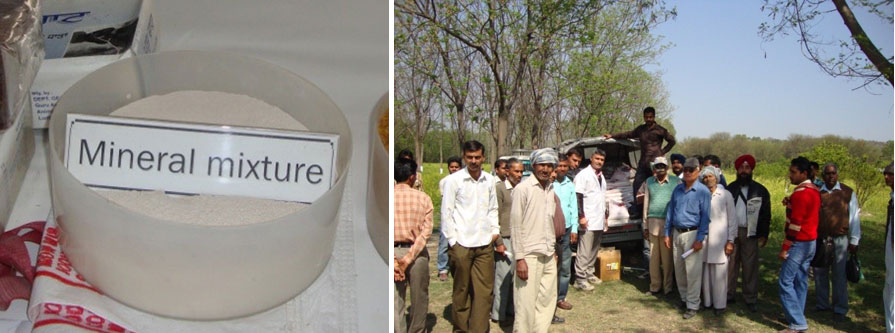
2. Supplementation of Uromin licks (UMMB)
In sub-mountainous zone of Punjab, most of the dairy animals are raised on roughage diet. Wheat straw, maize stovers, rice straw and millet stalks constitute the bulk of dry matter which often leads to deficiency of energy, protein and minerals. Under such circumstances, supplementation of urea molasses multi-nutrient blocks (UMMB) in the diet might prove a boon for the animals in Kandi belt.
UMMB is a brick shaped lick of about 3.00 kg weight providing slow releasing urea nitrogen along with 16 essential minerals. Uromin lick can supply 30-40 per cent of protein and more than 75 per cent of the daily mineral needs of medium producing dairy animals. It is an economical substitute of 1-2 kg concentrate mixture for grazing or stall fed animals. Its regular use can improve the reproductive performance of the cattle with better conception rate.
The farmers of Kandi area can be trained to prepare the UMMB at their own farm with the following ingredients
|
Ingredient |
Quantity |
| Urea | 300 g |
| Molasses | 900 g |
| Guar gum | 50 g |
| Mustard cake | 450 g |
| De-oiled rice bran | 300 g |
| Wheat flour | 450 g |
| Mineral mixture | 450 g |
| Common salt | 200 g |
| Calcium oxide | 100 g |
The lick is prepared by mixing urea with molasses and guar gum in a large vessel. After urea got completely dissolved, premix of wheat flour, mineral mixture, salt, rice polish, mustard cake and calcium oxide is added to it. The material is, then, pressed into a brick and is stored in a polythene bag. The lick could be kept in the manger and the animal is allowed to lick about half kilogram of it daily along with 5-10 kg green fodder and ad lib wheat straw. This is a convenient and economical way to provide balanced feed to an animal producing 5-6 kg milk/day.
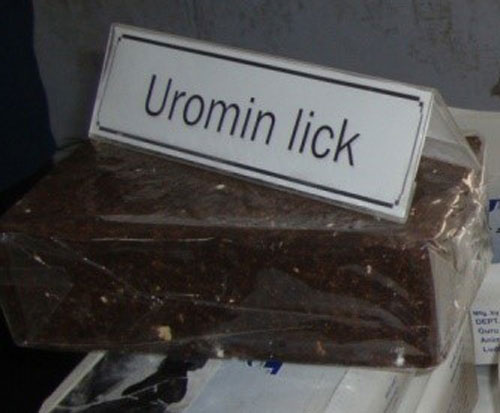
The farmers can be easily made aware of the level of daily supplementation (half kg) and feeding procedure of placing the UMMB in the manger and letting the animal lick as per its wish. During rainy season the licks can become soggy and soft and there are greater chances of the animal biting and eating the UMMB rather than licking. Hence, the farmers are advised to remove the lick from the manger if the consumption exceeds the daily limit to prevent oedema due to excessive intake of salt from the UMMB. As a precautionary measure, the farmers should be told not to feed the UMMB to calves below the age of 6 months as their rumen is not fully developed yet. Supplementation of UMMB to the lactating animals usually lead to an increase in half a kilogram (average) milk yield daily besides improving their body condition.

3. Supplementation of complete-feed blocks
The concept of total mixed ration (TMR) suggests that when a blend of concentrate mixture and roughage is offered to the animal, they get a completely balanced meal in every morsel they eat. This strategy allows greater use of locally available feed resources and crop residues in the ration, less feed wastage and feed selectivity, balanced and economical feed formulations and optimum utilization of nutrients. When fodder availability is limited, the best way to provide balanced ration to the milch animals throughout the year is by using fodder hay to make complete feed blocks. It is a compact feed, easy to transport and store.
These blocks improve the utilization of crop residues; increase milk production and reduce the drudgery in animal feeding. The complete feed blocks are prepared by mixing 43.0 kg wheat straw or paddy straw; 45.0 kg concentrate mixture, 7.00 kg molasses, 0.50 kg urea, 0.50 kg salt, 1.00 kg mineral mixture and 0.30 kg calcium oxide. Ten or fourteen kg mixture is pressed into a block-making-machine and packed in plastic bags. It is fed directly to the animal after removing the plastic bag.
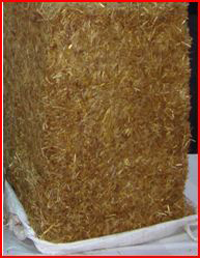
4. Improving fodder availability through introduction of improved varieties of fodder crops
The farmers of Kandi region usually grow unapproved cultivars of fodder crops of maize (Zea mays), bajra (Pennisetum typhoides) in kharif, and berseem (Trifolium alexandrinum) and oat (Avena sativa) in rabi season without following recommended agronomic practices. The yield of the green fodder crops is often very low (130-150 qt/acre). The introduction of improved varieties of fodder crops like maize (J-1006), millet (PCB 164), guinea grass (Panicum maximum) (PGG 1) and stem cuttings of Napier bajra hybrid (PBN-233) in kharif season, and berseem (BL 10 and BL 42), oats (Kent) and rye grass (Punjab Rye Grass No. 1) in rabi season can lead to improvement in the yield and quality of green fodder. By adopting the improved agronomic practices green fodder availability can go up significantly in summer season which can further increase during the rainy season.

 Fig.6: Fields of Berseem and Rye grass
Fig.6: Fields of Berseem and Rye grass
5. Fodder conservation through silage making
During rainy season, grass and fodder availability gets increased. Soon after rainy season, grasses and non-leguminous fodders like maize and bajra can be preserved through ensiling for future use during scarcity period of winter. Most of the farmers especially in Talwara block feed maize stovers to their animals during winter. The stovers are not nutritious and are often deficient in vital nutrients and hence might produce some deficiency diseases in farm animals. So, there is an urgent need for preservation of nutrients from green forages available during the flush period for feeding livestock during lean period so that animals could be sustained for profitable dairy farming.
Owing to small size of dairy farms in Kandi area, silage is prepared in polybags. Silage preparation in bags has a few advantages over pit silage making like less storage losses, better quality silage and lower cost (14-18%). In addition, the bags can be sealed easily; harvesting can be spread over longer periods, making it ideal for small farms.
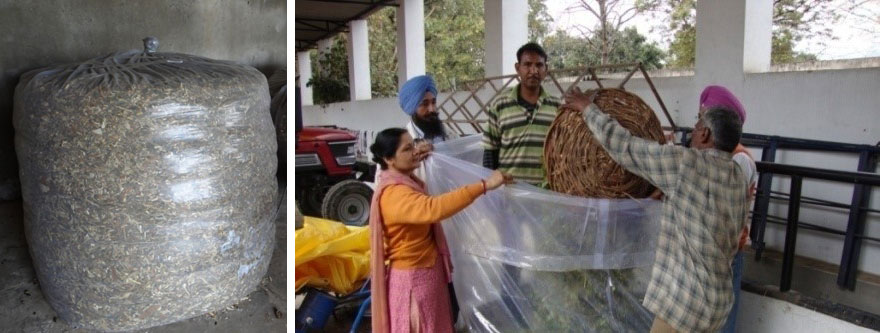
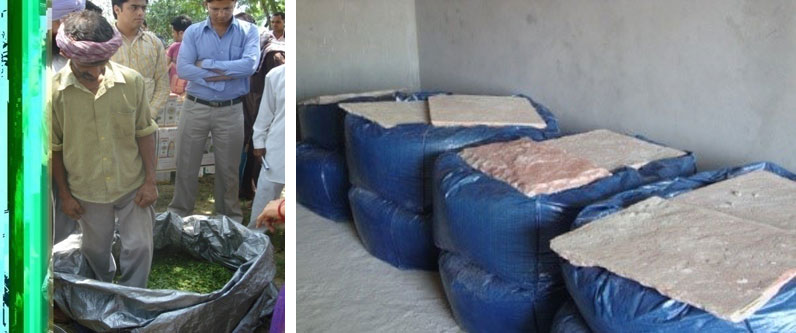 Fig.8: Silage making in HDPE plastic bag
Fig.8: Silage making in HDPE plastic bag
6. Enrichment of crop residues
Crop residues contain half the plant organic matter but cannot support effective animal production as they are highly fibrous, low in protein, fermentable energy and available minerals/vitamins. They are unpalatable and feeding them as sole feed can cause compaction of the rumen. The nutritive value of crop residues can be improved economically by using urea fermentation technology. This process increases the protein content, fiber digestibility, palatability and the product is laxative. This technology also increases milk production by 1.0-1.5 kg/day.
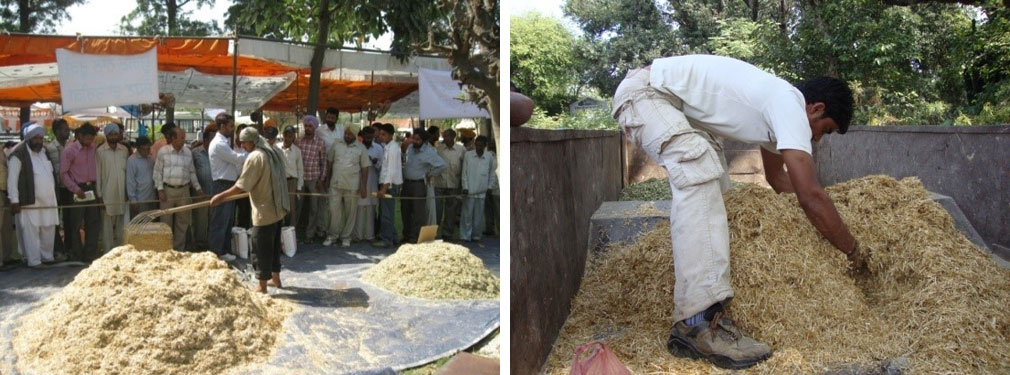
Around four quintals of wheat straw is chopped to 2-3 cm size particles and, then, spread on the floor. Thereafter, 14 kg urea is dissolved in 200 liters of water and sprayed evenly on the spread. After mixing with a rake, the straw is made into a stack in a corner and left aside for 9 days. The straw is fed to milch animals after exposing it to air. Initially each animal is fed 1-2 kg of treated straw and the amount is increased slowly as the animals get used to eating it.
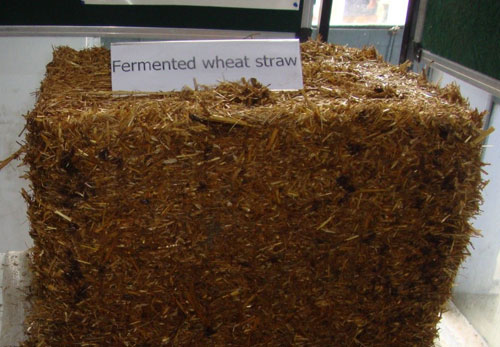
The urea fermentation technique improves the nutrient value of wheat straw as per following table.
Enhancement of nutritive value of wheat straw by urea fermentation
|
Parameters |
Untreated straw |
Urea fermented straw |
| Crude protein | 3.0-3.5 | 6.0-8.0 |
| Digestible crude protein | 0 | 3.0-4.0 |
| Total digestible nutrients | 40-45 | 50-55 |
| Dry matter intake | 5-6 | 10-12 |
Thus, the above listed technologies can significantly improve the nutritional status of animals especially in the Kandi area of Punjab.





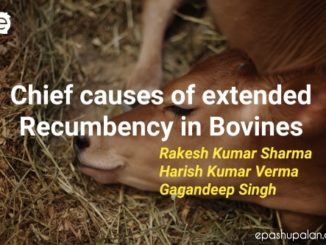

Be the first to comment